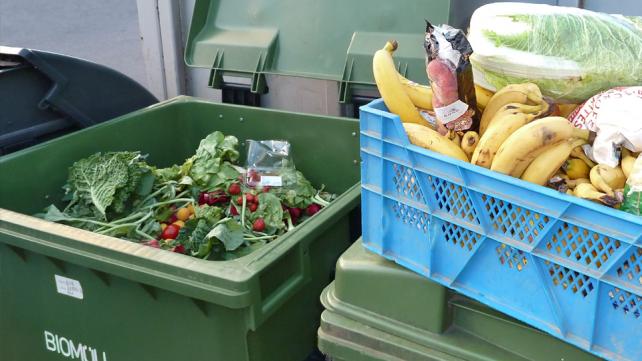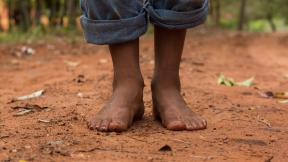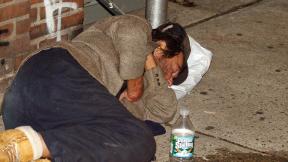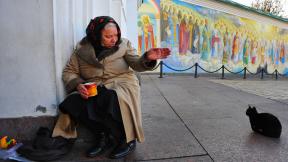
Poverty in America? One of the richest countries in the world?
Yes, poverty is a reality in America, just as it is for millions of other human beings on the planet. According to the US Census Bureau, 35.9 million people live below the poverty line in America, including 12.9 million children.
This is despite abundance of food resources. Almost 100 billion pounds of food is wasted in America each year. 700 million hungry human beings in different parts of the world would have gladly accepted this food.
Here are some statistics on the nature of poverty and the waste of food and money in America.
-In 2004, requests for emergency food assistance increased by an average of 14 percent during the year, according to a 27-city study by the United States Conference of Mayors.
-Also in this study, it was noted that on average, 20 percent of requests for emergency food assistance have gone unmet in 2004.
-According to the Bread for the World Institute 3.5 percent of U.S. households experience hunger. Some people in these households frequently skip meals or eat too little, sometimes going without food for a whole day. 9.6 million people, including 3 million children, live in these homes.
-America's Second Harvest (http://www.secondharvest.org/), the nation's largest network of food banks, reports that 23.3 million people turned to the agencies they serve in 2001, an increase of over 2 million since 1997. Forty percent were from working families.
33 million Americans continue to live in households that did not have an adequate supply of food. Nearly one-third of these households contain adults or children who went hungry at some point in 2000.
U.S. Dept. of Agriculture, March 2002, "Household Food Security in the United States, 2000"
Wasted food in America
-According to America’s Second Harvest, over 41 billion pounds of food have been wasted this year.
-According to a 2004 study from the University of Arizona (UA) in Tucson, on average, American households waste 14 percent of their food purchases.
Fifteen percent of that includes products still within their expiration date but never opened. Timothy Jones, an anthropologist at the UA Bureau of Applied Research in Anthropology who led the study, estimates an average family of four currently tosses out $590 per year, just in meat, fruits, vegetables and grain products.
Nationwide, Jones says, household food waste alone adds up to $43 billion, making it a serious economic problem.
- Official surveys indicate that every year more than 350 billion pounds of edible food is available for human consumption in the United States. Of that total, nearly 100 billion pounds - including fresh vegetables, fruits, milk, and grain products - are lost to waste by retailers, restaurants, and consumers.
-“U.S.-Massive Food Waste & Hunger Side by Side” by Haider Rizvi
-According to a 1997 study by US Department of Agriculture's Economic Research Service (ERS) entitled "Estimating and Addressing America's Food Losses", about 96 billion pounds of food, or more than a quarter of the 356 billion pounds of edible food available for human consumption in the United States, was lost to human use by food retailers, consumers, and foodservice establishments in 1995.
Fresh fruits and vegetables, fluid milk, grain products, and sweeteners (mostly sugar and high-fructose corn syrup) accounted for two-thirds of the losses. 16 billion pounds of milk and 14 billion pounds of grain products are also included in this loss.
Food that could have gone to millions
According to the US Department of Agriculture, up to one-fifth of America's food goes to waste each year, with an estimated 130 pounds of food per person ending up in landfills. The annual value of this lost food is estimated at around $31 billion But the real story is that roughly 49 million people could have been fed by those lost resources. (For your persona jihad against wastage, see A Citizen's Guide to Food Recovery
(The figures below are 1998 figures)
- Proportion of Americans living below the poverty level: 12.7 percent (34.5 million people)
- The average poverty threshold for a family of four: $16,660 in annual income
- The average poverty threshold for a family ofthree: $13,003 in annual income
- Poverty rate for metropolitan areas: 12.3 percent
- Poverty rate forthose living inside central cities: 18.5 percent
- Poverty rate for those living in the suburbs: 8.7 percent
- Percentage and number of poor children: 18.9 percent (13.5 million)
- Children make up 39 percent of the poor and 26 percent of the total population.
- The poverty rate for children is higher than for any other age group.
Child poverty:
- -for children under age 6 living in families with a female householder and no husband present: 54.8 percent
- -for children under age 6 in married-couple families: 10.1 percent
- Poverty rate for African Americans: 26.1 percent
- Poverty rate for Asians and Pacific Islanders: 12.5 percent
- Poverty rate for Hispanics of any race: 25.6 percent
- Poverty rate fornon-Hispanic whites: 8.2 percent
Photo Attribution: http://commons.wikimedia.org/wiki/File:Recovering_wasted_food.JPG








Comments
I had the privilegde to write my final Essay on this subject last year. I did a lot of research and you wont believe all the information I found out. Your article is very good and the poverty rate has most likely increased. I have not seen any new stats as of yet.
Location
Im sorry, did not mean to post that, I love Islam and this article is AWESOME! thank you so much Samana
Location
OMG THIS IS SO UBERLY AWESOME. THIS IS 1337!!! I USED THIS FOR MY RESEARCH PAPER OMG IT WAS SO AWESOME MAN AWESOME ARTICLE!!!
Location
Thanks for this information. It was very useful for my school project. Horray for statistics.
Location
this is totally easy to read and very factualvery helpful on my school project
Location
This was used for my school project. Thanx.!
Location
sean from ca needs to think about how he would like to work two or more jobs from morning til night. what about the kids in these families. and poverty stricken people are not stupid or untalented, just as all middle to upper class people are not smart and wonderfully talented. thanx.
Location
The article has great stats. but I would like to comment on another comment by Sean from California. I was wondering if he has lived and grown up in a poverty stricken area? If so he would understand that we must not blame the poor for being poor, we are only blaming the victim. He must understand that their lives are more of a cycle. It all starts with the poor (lack) of education thousands recieve as children and adolescents. Also if your is school is good or bad all depends on property taxes(Beverly Hills=great schools, after school programs, and tutoring for SATS, while Compton=bad schools, no after school programs, and no tutoring because of its budget cuts). Some do drop out of school to be able to get a job to help pay bills upon bills that their familys have to deal with. But lets say they don't drop out and they wish to go to college, they usually would get lower SAT scores because of the poor education they recieved in highschool. Its a disadvantage people get when they are raised in poor areas.So this would lead to jobs, don't be confused, thousands of poverty stricken persons have jobs ( most of the time two jobs). The reason they are still poor is because they have lowpaying jobs, and meritocracy is a myth. Many work all from sunrise to sunset, yet they cannot get out of the same poor area. So the cycle continues, that is why we can't blame America's victim, the poor, because it is not them who have to "get up and get a job" because they already do have them. We have to point the direction at those who have set up this cycle to keep the poor, poor and the wealthy, very wealthy.
Location
I come from one of the poorest states in the nation and what I think people often forget is that poverty is measured in wealth and not quality of life. People so unjustly deemed poor may live a better home life than a family who has grown up with millions. Yes there is a problem, yes it needs to be addressed, but I think it is hypocritical to criticize a problem you can't understand. Most of the people on this website are working from a personal or school funded computer so please tell me how poor YOU are. Get involved!!!!!!!!!!!
Location
i just came upon this article, but cannot find the date it was written. as of right now, there is no surplus, there is a federal budget deficit. but, more importantly, why does this happen? i don't think education is the answer, people know about it, they just don't care. look at who has the power in this country, it isn't the poor people, it is the wealthy. this is SUPPOSED to be a country of equal opportunity, but look at the differences in our schools. we have rich, good schools and poor, bad schools where not only are the schools in disrepair, lack adequate books, technology and money, but the children face violence, in school. columbine in colorado, everybody listened because it was a wealthy area...well, nobody even bothers to report on school violence in the poor schools. poverty is never going to be decreased in america until we give people equal opportunity, such as equal access to education and address america's classism which has become more apparent during the last 4 years.
Location
Pages
Add new comment